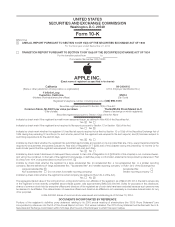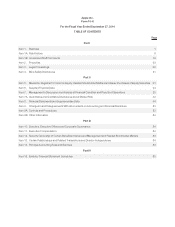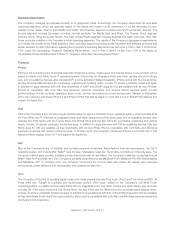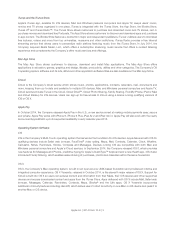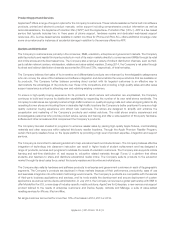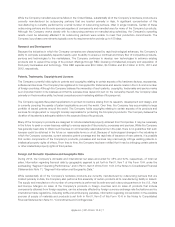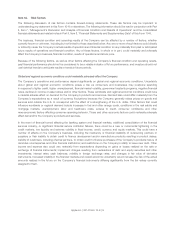Apple 2014 Annual Report Download - page 11
Download and view the complete annual report
Please find page 11 of the 2014 Apple annual report below. You can navigate through the pages in the report by either clicking on the pages listed below, or by using the keyword search tool below to find specific information within the annual report.Item 1A. Risk Factors
The following discussion of risk factors contains forward-looking statements. These risk factors may be important to
understanding any statement in this Form 10-K or elsewhere. The following information should be read in conjunction with Part
II, Item 7, “Management’s Discussion and Analysis of Financial Condition and Results of Operations” and the consolidated
financial statements and related notes in Part II, Item 8, “Financial Statements and Supplementary Data” of this Form 10-K.
The business, financial condition and operating results of the Company can be affected by a number of factors, whether
currently known or unknown, including but not limited to those described below. Any one or more of such factors could directly
or indirectly cause the Company’s actual results of operations and financial condition to vary materially from past or anticipated
future results of operations and financial condition. Any of these factors, in whole or in part, could materially and adversely
affect the Company’s business, financial condition, results of operations and stock price.
Because of the following factors, as well as other factors affecting the Company’s financial condition and operating results,
past financial performance should not be considered to be a reliable indicator of future performance, and investors should not
use historical trends to anticipate results or trends in future periods.
Global and regional economic conditions could materially adversely affect the Company.
The Company’s operations and performance depend significantly on global and regional economic conditions. Uncertainty
about global and regional economic conditions poses a risk as consumers and businesses may postpone spending
in response to tighter credit, higher unemployment, financial market volatility, government austerity programs, negative financial
news, declines in income or asset values and/or other factors. These worldwide and regional economic conditions could have
a material adverse effect on demand for the Company’s products and services. Demand also could differ materially from the
Company’s expectations as a result of currency fluctuations because the Company generally raises prices on goods and
services sold outside the U.S. to correspond with the effect of a strengthening of the U.S. dollar. Other factors that could
influence worldwide or regional demand include increases in fuel and other energy costs, conditions in the real estate and
mortgage markets, unemployment, labor and healthcare costs, access to credit, consumer confidence and other
macroeconomic factors affecting consumer spending behavior. These and other economic factors could materially adversely
affect demand for the Company’s products and services.
In the event of financial turmoil affecting the banking system and financial markets, additional consolidation of the financial
services industry, or significant financial service institution failures, there could be a new or incremental tightening in the
credit markets, low liquidity and extreme volatility in fixed income, credit, currency and equity markets. This could have a
number of effects on the Company’s business, including the insolvency or financial instability of outsourcing partners or
suppliers or their inability to obtain credit to finance development and/or manufacture products resulting in product delays;
inability of customers, including channel partners, to obtain credit to finance purchases of the Company’s products; failure of
derivative counterparties and other financial institutions; and restrictions on the Company’s ability to issue new debt. Other
income and expense also could vary materially from expectations depending on gains or losses realized on the sale or
exchange of financial instruments; impairment charges resulting from revaluations of debt and equity securities and other
investments; interest rates; cash balances; volatility in foreign exchange rates; and changes in fair value of derivative
instruments. Increased volatility in the financial markets and overall economic uncertainty would increase the risk of the actual
amounts realized in the future on the Company’s financial instruments differing significantly from the fair values currently
assigned to them.
Apple Inc. | 2014 Form 10-K | 9

